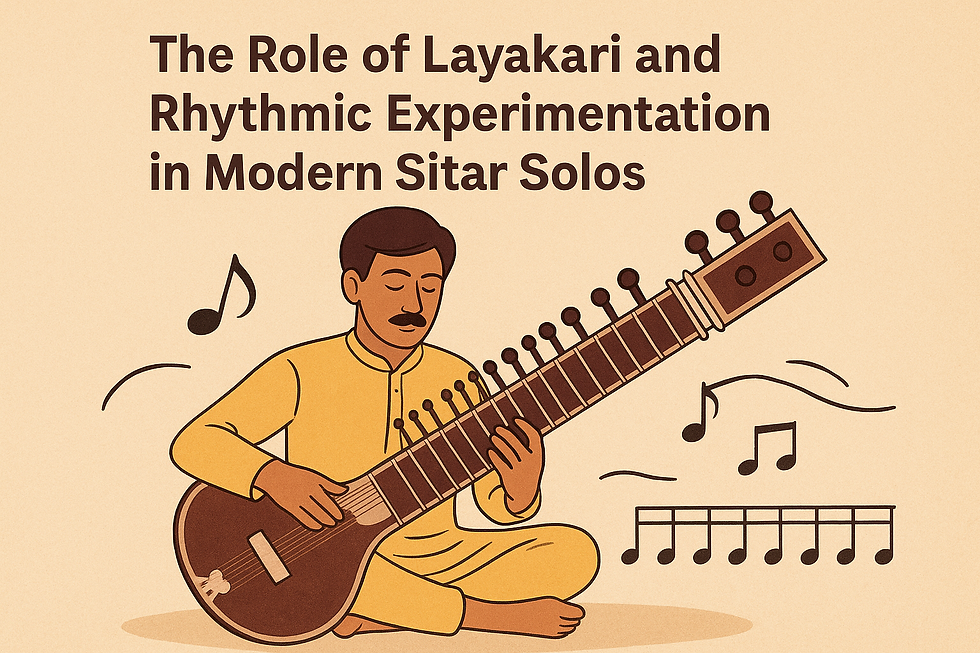"From Concert Stage to Quiet Space: The Sitar’s Journey into Yoga"
- Sharanya naidu
- May 20, 2025
- 3 min read
Updated: May 27, 2025
The gentle pull of a meend (glissando) on a sitar string can feel like a tug on the soul — slow,emotive, and immersive. In the West, the sitar has often been associated with spirituality, mindfulness, and the mystical East. From incense-scented yoga studios to ambient meditation playlists, its sounds are omnipresent. But how rooted is this association in Indian tradition? Is the sitar truly a meditative instrument, or has it become a symbol shaped by cultural projection? Let’s unpack the myth and the method.

🌿 A Soundtrack for Stillness?
Myth or Misunderstanding?
In India, the sitar has historically been a concert instrument, especially in the Khayal and instrumental Hindustani traditions. Its primary function has been artistic expression rather than meditation aid. However, its deep, resonant tones and flowing melodic lines make it ideal for creating a tranquil atmosphere.
The association of the sitar with yoga and meditation began in earnest during the 1960s countercultural movement, largely influenced by figures like Pandit Ravi Shankar. As Western audiences sought spiritual alternatives, Indian instruments became sonic icons of "inner peace."
Cultural Borrowing and Recontextualization
The use of sitar in yoga studios outside India is largely a Western recontextualization. In India, Dhrupad vocal, tanpura drone, or even chanting and bhajans are more traditionally used for meditative practices. Yet, the psychoacoustic qualities of the sitar — its long sustain, sympathetic strings, and nuanced microtones — do lend themselves beautifully to contemplative listening.
🧘♀️ The Science of Sitar and Stillness
Recent research in music cognition supports the idea that slow alap sections of a raga, especially when played on the sitar, can reduce cortisol levels, lower heart rate, and induce theta brainwave activity, all of which are associated with meditative states. This isn't mystical—it’s measurable.
The structure of a raga, particularly its gradual development from silence to rhythm (alap to jod to jhala), mimics the journey inward — a methodical quieting of the mind. Instruments like the sitar, which allow for extended meend (glides between notes), naturally align with breath-based mindfulness practices.
🎧 Sitar as a Modern Meditation Tool
Today, many contemporary artists intentionally compose meditative sitar music, with fewer rhythmic elements and longer note holds, explicitly for yoga and mindfulness sessions. These are not classical performances, but rather hybrid genres inspired by raga frameworks and tailored for meditation.
Platforms like Spotify and YouTube feature playlists titled "Sitar for Meditation," "Yoga Sitar," or "Healing Ragas" — a modern phenomenon, but not without musical integrity.
🎤 A Word from the Tradition
Some classical purists may argue that using raga music or sitar outside its formal context dilutes its depth. Others see this as a natural evolution, a way of making classical music accessible to a broader, even therapeutic, audience.
As Ustad Shahid Parvez Khan once said:
“Music is a spiritual practice. Whether in a concert hall or in solitude, it is about elevating the self.”
Conclusion: Method Within the Myth
So, is the sitar's place in yoga and meditation a myth or a method?
It’s both.What began as a cultural myth — a romanticization of the East — has, over time, found real application. The sitar's sound is not just evocative; it is effective. When used intentionally, it can support inner stillness and focus.
Whether you're a yoga teacher curating playlists or a student of Hindustani music, understanding the roots and routes of this instrument adds meaning to every note.



Comments